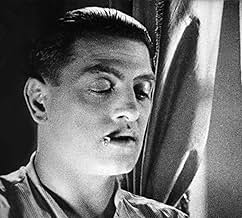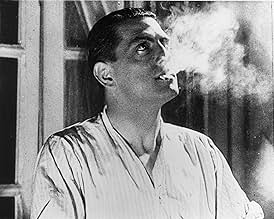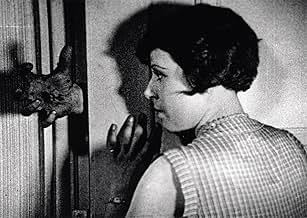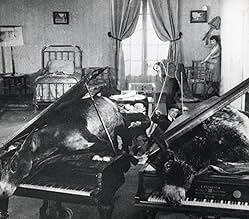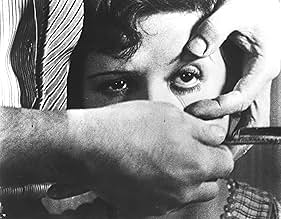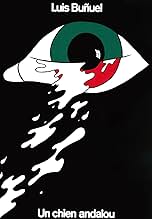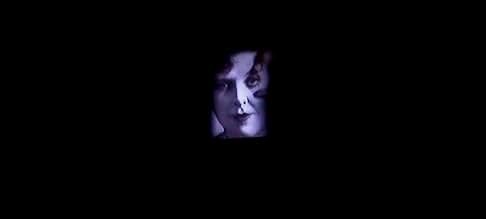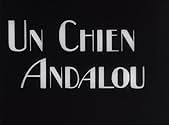AVALIAÇÃO DA IMDb
7,6/10
56 mil
SUA AVALIAÇÃO
Buñuel e Dalí exploram o inconsciente humano, numa sequência de cenas oníricas, incluindo o célebre momento em que um homem, interpretado pelo próprio diretor, corta, com uma navalha, o olho... Ler tudoBuñuel e Dalí exploram o inconsciente humano, numa sequência de cenas oníricas, incluindo o célebre momento em que um homem, interpretado pelo próprio diretor, corta, com uma navalha, o olho de uma mulher.Buñuel e Dalí exploram o inconsciente humano, numa sequência de cenas oníricas, incluindo o célebre momento em que um homem, interpretado pelo próprio diretor, corta, com uma navalha, o olho de uma mulher.
- Direção
- Roteiristas
- Artistas
Pierre Batcheff
- Man
- (as Pierre Batchef)
Simone Mareuil
- Young Girl
- (as Simonne Mareuil)
Luis Buñuel
- Man in Prologue
- (não creditado)
Pancho Cossío
- Stroller
- (não creditado)
Salvador Dalí
- Seminarist
- (não creditado)
Juan Esplandiu
- Stroller
- (não creditado)
Robert Hommet
- Young Man
- (não creditado)
Marval
- Seminarist
- (não creditado)
Fano Messan
- Hermaphrodite
- (não creditado)
Jaume Miravitlles
- Fat Seminarist
- (não creditado)
- Direção
- Roteiristas
- Elenco e equipe completos
- Produção, bilheteria e muito mais no IMDbPro
Avaliações em destaque
Good way to sample the filmography of Luis Bunuel is to begin with this surreal short. An excellent intro to Bunuel's more mature work because his films are full of bizarre images that began here. Un Chien Andalou(1929) like the rest of Bunuel's early works experiments with use of film image and surrealism. Illustrates the beginning of a career full of amazing, bizarre, and subversive films. Things could only get better for Bunuel's film career and they did.
Un Chien Andalou(1929) was an artful collaboration between two surrealistic masters in Luis Bunuel and Salvador Dali. These two artists were part of a surrealism movement in Spain that influenced the country's art. Bunuel and Dali had a fruitful but short film partnership that ended once each wanted to go their separate ways. After the early 1930s these talented artists would never work with each other again. For Un Chien Andalou(1929), Bunuel and Dali created images of eccentric force based on their day and night dreams.
Surrealism was very popular in early 20th Century art especially during the 1920s. The surrealist movement took shape in places like France and Spain where it flourished for a period of time before falling apart in 1930s. Un Chien Andalou(1929) is a good example of what made the surrealist movement tick. Salvador Dali designs images with social and symbolic meanings. Bunuel's skills as a surrealist as first shown here would become more abstract once he started mastering his craft.
Plotless short film that is basically a series of images. Un Chien Andalou(1929) is an 'Absolute Film' which relies on abstract imagery in an attempt to unnerve the viewer. In Bunuel's early films, imagery took precedent over things like dialogue and plot. In the history of cinema its a rarity especially since the beginning of the sound era for pure imagery to be the sole existence in a motion picture. Un Chien Andalou(1929) contains images that ranges from the erotic, frightening, funny, strange, and symbolic.
Bunuel's direction for Un Chien Andalou(1929) is very good considering its his first piece of cinematic work as a film director. He uses the same type of dreamlike logic here that prevails in his best films. He directs each image with unlimited imagination. Direction for Un Chien Andalou(1929) may be crude a little unsophisticated but its still fascinating to observe. Luis Bunuel first put his name among the cinematic ranks with the historical important, Un Chien Andalou(1929).
Forever immortalized on celluloid is the eye slicing image of Un Chien Andalou(1929). Cinema's fascination with eye motif probably began here and continued from then on. The destruction of sight is an important them in Un Chien Andalou(1929) and other cinematic works. Jean Vigo remarked in opinion of eye slicing image, "Is it more dreadful than the Spectacle of a cloud veiling a full moon"? Eye slicing image was influential to Italian horror espically to the films of Lucio Fulci and Mario Bava(the former did an updated version of image with eye penetration moment from Zombie Flesh Eaters[1979]).
Caused an enormous scandal in the late 1920s with depiction of disturbing and outright strange imagery. I can picture the reaction of disgust and shock on audiences faces as they watch tongue tied at the images that bombard their senses. Un Chien Andalou(1929) may have lost a little of its shock power by today's standards. Still this short film continues to retain the ability to dare which is an improbability in today's Hollywood cinema. Luis Bunuel's next film, L'Age D'Or(1930) caused an even bigger scandal and riots broke out during the film's opening show.
Not much in the way of substancial acting in a film where characters exist only as impulses and symbols. One of the most important pieces of film during first half of 20th Century cinema. Showed filmmakers that the power to provoke is as important as acting, cinemtography, dialogue, and plot. Un Chien Andalou I think is a forethought to the daring and subversive films of period covering 1967 to 1977. Un Chien Andalou(1929) I feel is the near last of a group of films concerned with film imagery that occupied the silent film genre for twenty plus years.
A motion picture ahead of its time in more ways than one. One reason its ahead of its time is the image of a woman's bare naked breasts being touched by male hands. Image such as one mentioned above was unusual for the period the film was made. Also, there are a couple of images in the film that are on the slightly gory side. Obviously done by a young Bunuel who was more sexually open minded than the older man who though an on screen kiss was obscene.
Bunuel's fetishes and Obsessions that occupied the images of Un Chien Andalou becomes maturely developed in later films. Couple of motifs from Un Chien Andalou shows up in films like Simon del Desierto(1965). Dreamlike imagery of short frequents the stories of El Angel Exterminador(1962) and Belle De Jour(1967). Its a warmup to Bunuel's next film, L'Age D'Or(1930) which is also his first feature length film. Un Chien Andalou(1929) is an exercise in artistic expression and artistic vision by an artistic genius.
Un Chien Andalou(1929) was an artful collaboration between two surrealistic masters in Luis Bunuel and Salvador Dali. These two artists were part of a surrealism movement in Spain that influenced the country's art. Bunuel and Dali had a fruitful but short film partnership that ended once each wanted to go their separate ways. After the early 1930s these talented artists would never work with each other again. For Un Chien Andalou(1929), Bunuel and Dali created images of eccentric force based on their day and night dreams.
Surrealism was very popular in early 20th Century art especially during the 1920s. The surrealist movement took shape in places like France and Spain where it flourished for a period of time before falling apart in 1930s. Un Chien Andalou(1929) is a good example of what made the surrealist movement tick. Salvador Dali designs images with social and symbolic meanings. Bunuel's skills as a surrealist as first shown here would become more abstract once he started mastering his craft.
Plotless short film that is basically a series of images. Un Chien Andalou(1929) is an 'Absolute Film' which relies on abstract imagery in an attempt to unnerve the viewer. In Bunuel's early films, imagery took precedent over things like dialogue and plot. In the history of cinema its a rarity especially since the beginning of the sound era for pure imagery to be the sole existence in a motion picture. Un Chien Andalou(1929) contains images that ranges from the erotic, frightening, funny, strange, and symbolic.
Bunuel's direction for Un Chien Andalou(1929) is very good considering its his first piece of cinematic work as a film director. He uses the same type of dreamlike logic here that prevails in his best films. He directs each image with unlimited imagination. Direction for Un Chien Andalou(1929) may be crude a little unsophisticated but its still fascinating to observe. Luis Bunuel first put his name among the cinematic ranks with the historical important, Un Chien Andalou(1929).
Forever immortalized on celluloid is the eye slicing image of Un Chien Andalou(1929). Cinema's fascination with eye motif probably began here and continued from then on. The destruction of sight is an important them in Un Chien Andalou(1929) and other cinematic works. Jean Vigo remarked in opinion of eye slicing image, "Is it more dreadful than the Spectacle of a cloud veiling a full moon"? Eye slicing image was influential to Italian horror espically to the films of Lucio Fulci and Mario Bava(the former did an updated version of image with eye penetration moment from Zombie Flesh Eaters[1979]).
Caused an enormous scandal in the late 1920s with depiction of disturbing and outright strange imagery. I can picture the reaction of disgust and shock on audiences faces as they watch tongue tied at the images that bombard their senses. Un Chien Andalou(1929) may have lost a little of its shock power by today's standards. Still this short film continues to retain the ability to dare which is an improbability in today's Hollywood cinema. Luis Bunuel's next film, L'Age D'Or(1930) caused an even bigger scandal and riots broke out during the film's opening show.
Not much in the way of substancial acting in a film where characters exist only as impulses and symbols. One of the most important pieces of film during first half of 20th Century cinema. Showed filmmakers that the power to provoke is as important as acting, cinemtography, dialogue, and plot. Un Chien Andalou I think is a forethought to the daring and subversive films of period covering 1967 to 1977. Un Chien Andalou(1929) I feel is the near last of a group of films concerned with film imagery that occupied the silent film genre for twenty plus years.
A motion picture ahead of its time in more ways than one. One reason its ahead of its time is the image of a woman's bare naked breasts being touched by male hands. Image such as one mentioned above was unusual for the period the film was made. Also, there are a couple of images in the film that are on the slightly gory side. Obviously done by a young Bunuel who was more sexually open minded than the older man who though an on screen kiss was obscene.
Bunuel's fetishes and Obsessions that occupied the images of Un Chien Andalou becomes maturely developed in later films. Couple of motifs from Un Chien Andalou shows up in films like Simon del Desierto(1965). Dreamlike imagery of short frequents the stories of El Angel Exterminador(1962) and Belle De Jour(1967). Its a warmup to Bunuel's next film, L'Age D'Or(1930) which is also his first feature length film. Un Chien Andalou(1929) is an exercise in artistic expression and artistic vision by an artistic genius.
Luis Buñuel, Calanda, in the province of Teruel in the south of the region called Aragón, a town itself afamed for the twenty-four hour non-stop drums (`la tamborada') in the streets played by hundreds of people together in Holy Week, as a young man fled to Paris with the intention of doing something great in this world. There he met Salvador Dalí who had done the same, leaving his native Catalonia in his mid twenties - some five years younger than Buñuel - with more or less the same ideas in his head.
These two young men, who in later years were to be known - even admired in some cases - as the most extravagant and flamboyant creators of art, were not alone. Pablo Picasso, not yet 50, had already been blazing the trail, to mention another Spaniard among those thronging the avant-garde Paris of the times. Claude Debussy and Maurice Ravel had led the impressionist movement in music for many years, and the `Imagiste' school in poetry was well under way. Anybody who was anybody in the artistic world flocked to Paris, and either made a hit and became someone eminent, or did not.
Cinema was a new art form still to be experimented with; no wonder, then, that these two men of evidently original ideas trying to burst out of them, had to do something so as to gatecrash into the gentry of the established circles of artistes and would-be artistes or hangers-on. The Buñuel-Dalí tandem knew they would produce something different; not necessarily to scandalize anyone, but more with the purpose of attracting attention, whether from intellectuals, artists or their entrepreneurs, or just newspaper editors. Simply following the logical sequence that words can be poetic and an image is worth a thousand words, and that poetry can be abstract, thus so can images, and if they move - better still.
Buñuel got a bit of money out of his mother's purse, and thus the two young men had finance to start on making an abstract poetic sequence which did not pretend to have any logical meaning of any kind. `Un Chien Andalou' was to exist in the same way that any later painting either by Picasso or by Dalí himself would exist without necessarily purporting to mean anything, either significant or insignificant, and without necessarily any implicit objective - far less objective - raison d'etre than simply existing in itself. Whether the result could or should be considered `art' in any quintessential sense is/was up to the pundits, pseudointellectuals, newspaper critics, or anybody else who thought he had any ideas on the matter. Buñuel himself says in his autobiography `My Last Breath' that he would have quite happily burnt the film, but that would not have made any difference anyway.
`Un Chien Andalou' was the only silent film he made; whether because of lack of funds or otherwise intentionally, is hard to say. `L'Age d'Or' one year later had sound; however I cannot help thinking that Buñuel and Dali wanted to make a silent film, which then does not explain why in the 1960s Buñuel chose to add music - Wagner interspersed with a tango, a blatently at-odds combination - which would seem to have been some attempt at being unfaithful to the original. But Buñuel was nothing if not a contradictory person, to say the least. But by the 1960s he was beginning to turn out his best repertoire - `Viridiana' (qv), `Tristana', etc - and maybe his sense of maturity reigned over his other feelings, compelling him to `up-date' the film for newer audiences, even though he might be accused of unloyalty.
But, how does one remain loyal to abstract concepts which defy rationality?
Thus `Un Chien Andalou' remains one of the most misunderstood pieces of art to have ever been made public, and is perhaps the most widely-known short film of all time.
These two young men, who in later years were to be known - even admired in some cases - as the most extravagant and flamboyant creators of art, were not alone. Pablo Picasso, not yet 50, had already been blazing the trail, to mention another Spaniard among those thronging the avant-garde Paris of the times. Claude Debussy and Maurice Ravel had led the impressionist movement in music for many years, and the `Imagiste' school in poetry was well under way. Anybody who was anybody in the artistic world flocked to Paris, and either made a hit and became someone eminent, or did not.
Cinema was a new art form still to be experimented with; no wonder, then, that these two men of evidently original ideas trying to burst out of them, had to do something so as to gatecrash into the gentry of the established circles of artistes and would-be artistes or hangers-on. The Buñuel-Dalí tandem knew they would produce something different; not necessarily to scandalize anyone, but more with the purpose of attracting attention, whether from intellectuals, artists or their entrepreneurs, or just newspaper editors. Simply following the logical sequence that words can be poetic and an image is worth a thousand words, and that poetry can be abstract, thus so can images, and if they move - better still.
Buñuel got a bit of money out of his mother's purse, and thus the two young men had finance to start on making an abstract poetic sequence which did not pretend to have any logical meaning of any kind. `Un Chien Andalou' was to exist in the same way that any later painting either by Picasso or by Dalí himself would exist without necessarily purporting to mean anything, either significant or insignificant, and without necessarily any implicit objective - far less objective - raison d'etre than simply existing in itself. Whether the result could or should be considered `art' in any quintessential sense is/was up to the pundits, pseudointellectuals, newspaper critics, or anybody else who thought he had any ideas on the matter. Buñuel himself says in his autobiography `My Last Breath' that he would have quite happily burnt the film, but that would not have made any difference anyway.
`Un Chien Andalou' was the only silent film he made; whether because of lack of funds or otherwise intentionally, is hard to say. `L'Age d'Or' one year later had sound; however I cannot help thinking that Buñuel and Dali wanted to make a silent film, which then does not explain why in the 1960s Buñuel chose to add music - Wagner interspersed with a tango, a blatently at-odds combination - which would seem to have been some attempt at being unfaithful to the original. But Buñuel was nothing if not a contradictory person, to say the least. But by the 1960s he was beginning to turn out his best repertoire - `Viridiana' (qv), `Tristana', etc - and maybe his sense of maturity reigned over his other feelings, compelling him to `up-date' the film for newer audiences, even though he might be accused of unloyalty.
But, how does one remain loyal to abstract concepts which defy rationality?
Thus `Un Chien Andalou' remains one of the most misunderstood pieces of art to have ever been made public, and is perhaps the most widely-known short film of all time.
I still remember my visit to Philadelphia Museum of Art, back in the April of 2005. One of the reasons I went there was to to see the Salvador Dali's exhibitions but the tickets were sold out. While in the museum, I was able to see two films that Dali was a big part of. In the video Gallery of the museum, two intriguing projects have been running together in the continuous loop, the early "Un Chien Andalou" (17 minutes) and the recently released, animated Destino (6 minutes). This was the first viewing for me. I kept coming back to the gallery few more times and I never was tired of both short films.
The inspiration for "Un Chien Andalou" began with the dreams of two young rebellious men, the artists and the friends, Luis Bunuel and Salvador Dali. They exchanged the dreams they both had, Bunuel - about a slender cloud slicing the moon in half "like a razor blade slicing through an eye", and Dali - about a dream involving a hand enveloped by ants. Both artists soon began working on a film script based on these ideas.
Made in 1929, the film has not aged at all. Its disconnected but haunting scenes and images are as shocking today (at least, for me they were) as I am sure they were all these years ago for the viewers who faced them for the first time. The reason the film is so powerful even now may be the themes of love, sex, death, and decay that are eternal and will always attract the artists and audiences alike. It is also could be in the establishing and following by both artists the certain rules, "No idea or image that might lend itself to a rational explanation of any kind will be accepted...We had to open all doors to the irrational and keep only those images that surprised us without trying to explain why." Perhaps, Dali and Bunuel intended their film to be experienced directly, on the visceral level, and not analyzed by the viewers.
The inspiration for "Un Chien Andalou" began with the dreams of two young rebellious men, the artists and the friends, Luis Bunuel and Salvador Dali. They exchanged the dreams they both had, Bunuel - about a slender cloud slicing the moon in half "like a razor blade slicing through an eye", and Dali - about a dream involving a hand enveloped by ants. Both artists soon began working on a film script based on these ideas.
Made in 1929, the film has not aged at all. Its disconnected but haunting scenes and images are as shocking today (at least, for me they were) as I am sure they were all these years ago for the viewers who faced them for the first time. The reason the film is so powerful even now may be the themes of love, sex, death, and decay that are eternal and will always attract the artists and audiences alike. It is also could be in the establishing and following by both artists the certain rules, "No idea or image that might lend itself to a rational explanation of any kind will be accepted...We had to open all doors to the irrational and keep only those images that surprised us without trying to explain why." Perhaps, Dali and Bunuel intended their film to be experienced directly, on the visceral level, and not analyzed by the viewers.
this movie may be dated in a certain sense, but the vitality and passion of its vicious rebellion against societal taboos and constraints still comes through full throttle. bunuel, master of cinematic/surrealist revolt, violates every boundary he can think of. a woman's eyeball is slashed open, her chest brutally groped, ants crawl out of a man's hand, etc. this is more of a curiosity than anything else, but I am a surrealism fanatic and love this along with Cocteau's "Blood of a Poet". the reviewers here who downplay it's value are simply wrong and probably decided in advance to dislike it to look different.
Luis Buñuel and Salvador Dalí's "Un Chien Andalou" (1929) is not merely a film-it is a visceral assault on logic, a 16-minute plunge into the subconscious that redefined the boundaries of cinema. Emerging from the feverish collaboration of two avant-garde titans, this short film remains a cornerstone of surrealist art, blending dreamlike absurdity with shocking imagery to challenge the very notion of narrative coherence.
The film's structure mirrors the disjointed, irrational flow of a dream, eschewing traditional storytelling for a series of jarring vignettes. From the infamous opening scene-a cloud slicing the moon as a razor slits a woman's eyeball -to ants crawling from a man's palm and rotting donkeys draped over pianos, Buñuel and Dalí weaponize Freudian symbolism to evoke primal fears and desires. The creators famously declared that their only rule was to reject any rational explanation for the film's imagery, insisting that interpretation lies solely in the realm of psychoanalysis. This deliberate ambiguity transforms the viewer into an active participant, forced to confront their own subconscious reactions.
Shot on a shoestring budget over two weeks, the film's technical audacity remains striking. Buñuel's stark black-and-white cinematography and abrupt edits amplify the surreal atmosphere, while the use of a cow's eye for the slicing scene (to avoid harming an actor) underscores the visceral realism of the grotesque.
"Un Chien Andalou" defies categorization. It is neither a story nor a manifesto but a raw, unfiltered excavation of the human psyche. As Buñuel later quipped, "Nothing in the film symbolizes anything" , yet its power lies precisely in this refusal to conform. To watch it is to surrender to chaos-to let the ants crawl, the razors slash, and the donkeys rot. Nearly a century later, it remains a testament to art's ability to unsettle, provoke, and transcend.
A landmark of surrealism, "Un Chien Andalou" is essential viewing for anyone willing to brave its unnerving beauty. Just don't expect answers-only questions, writ large in blood and celluloid.
The film's structure mirrors the disjointed, irrational flow of a dream, eschewing traditional storytelling for a series of jarring vignettes. From the infamous opening scene-a cloud slicing the moon as a razor slits a woman's eyeball -to ants crawling from a man's palm and rotting donkeys draped over pianos, Buñuel and Dalí weaponize Freudian symbolism to evoke primal fears and desires. The creators famously declared that their only rule was to reject any rational explanation for the film's imagery, insisting that interpretation lies solely in the realm of psychoanalysis. This deliberate ambiguity transforms the viewer into an active participant, forced to confront their own subconscious reactions.
Shot on a shoestring budget over two weeks, the film's technical audacity remains striking. Buñuel's stark black-and-white cinematography and abrupt edits amplify the surreal atmosphere, while the use of a cow's eye for the slicing scene (to avoid harming an actor) underscores the visceral realism of the grotesque.
"Un Chien Andalou" defies categorization. It is neither a story nor a manifesto but a raw, unfiltered excavation of the human psyche. As Buñuel later quipped, "Nothing in the film symbolizes anything" , yet its power lies precisely in this refusal to conform. To watch it is to surrender to chaos-to let the ants crawl, the razors slash, and the donkeys rot. Nearly a century later, it remains a testament to art's ability to unsettle, provoke, and transcend.
A landmark of surrealism, "Un Chien Andalou" is essential viewing for anyone willing to brave its unnerving beauty. Just don't expect answers-only questions, writ large in blood and celluloid.
Você sabia?
- CuriosidadesAt the Paris premiere, Luis Buñuel hid behind the screen with stones in his pockets for fear of being attacked by the confused audience. Nothing of the sort happened. In fact, the audience loved its mysterious and incomprehensible plot.
- Versões alternativasThe film was re-released in 1960 with soundtracks.
- ConexõesEdited into Avant-garde Cinema (1960)
Principais escolhas
Faça login para avaliar e ver a lista de recomendações personalizadas
- Does "Un Chien Andalou" mean something?
Detalhes
- Tempo de duração16 minutos
- Cor
- Mixagem de som
- Proporção
- 1.33 : 1
Contribua para esta página
Sugerir uma alteração ou adicionar conteúdo ausente

Principal brecha
By what name was Um Cão Andaluz (1929) officially released in India in English?
Responda

